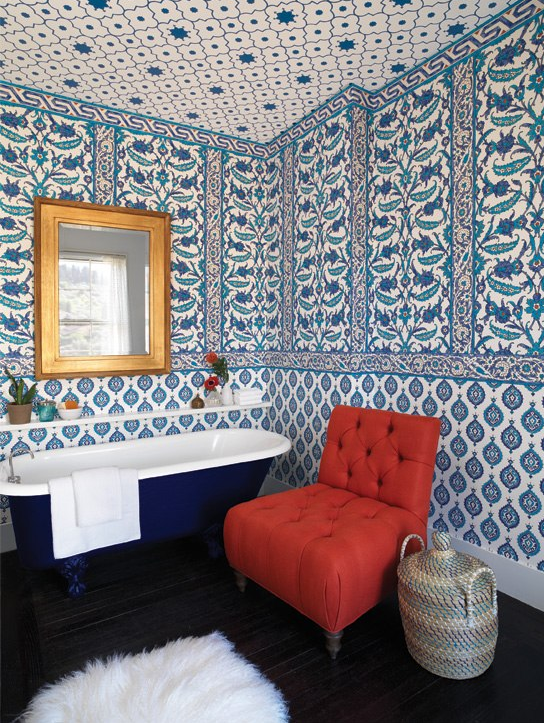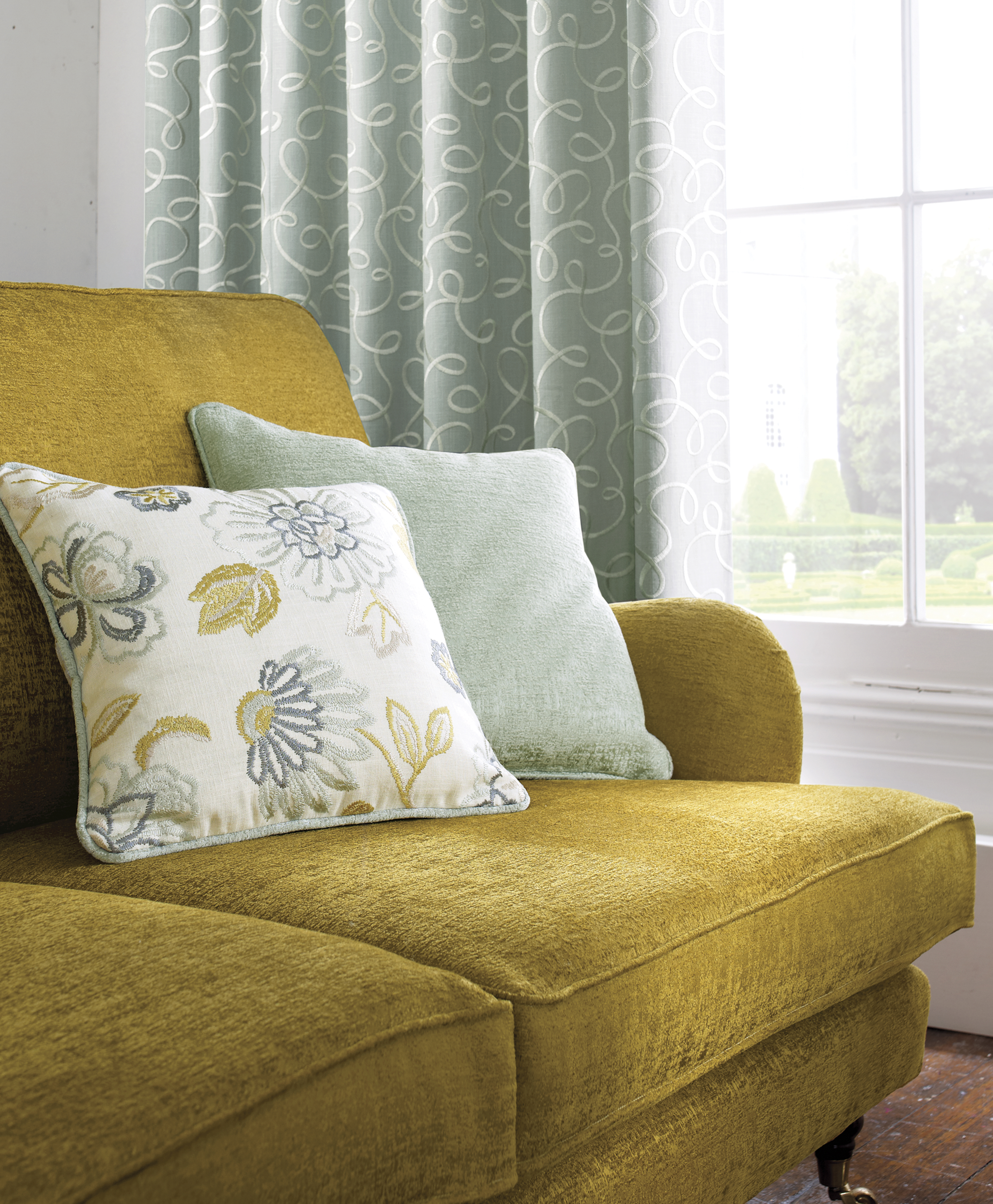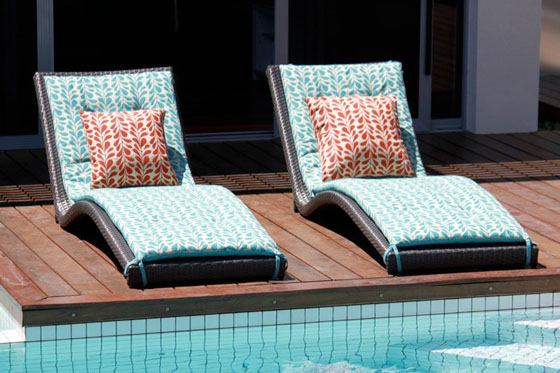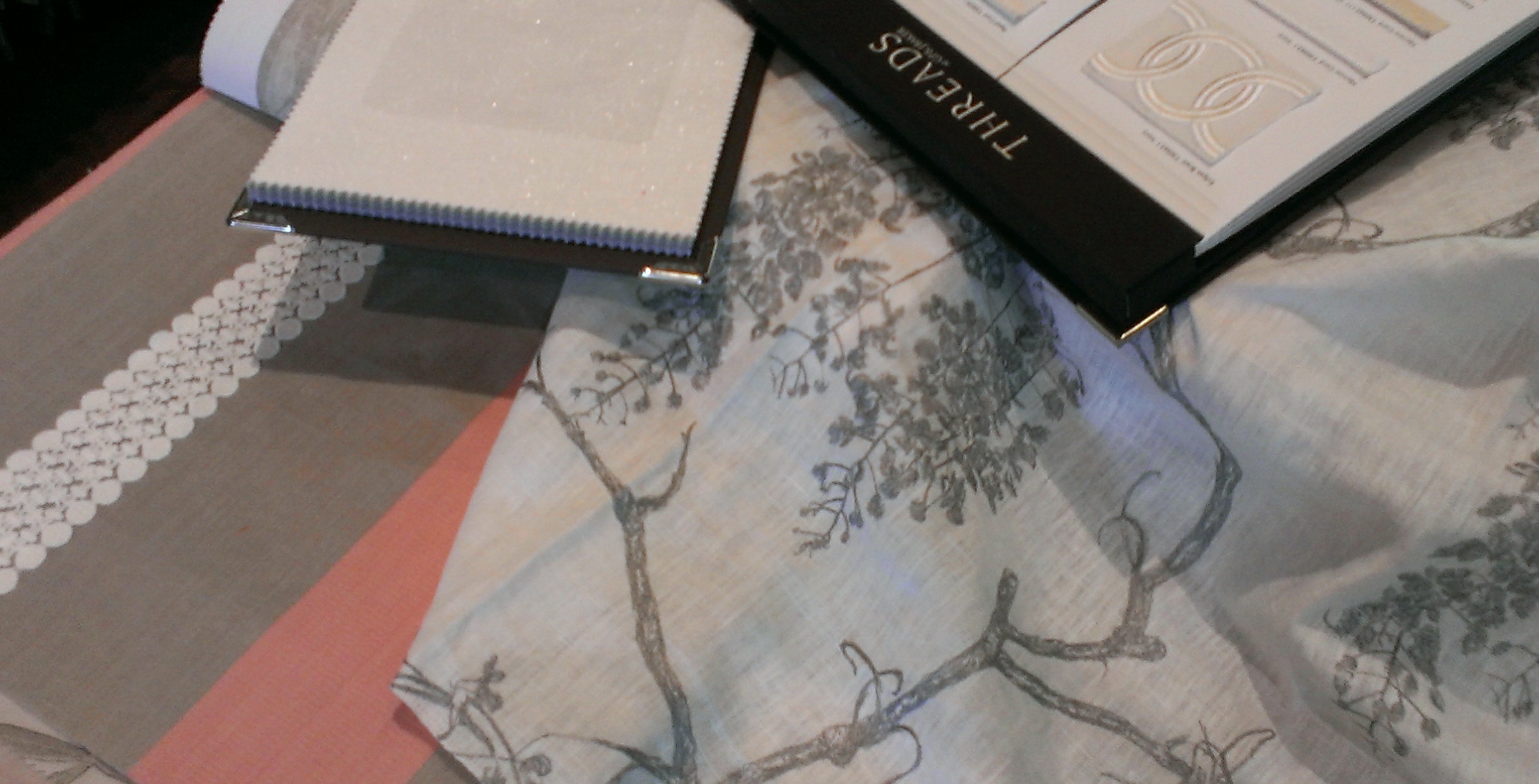Categories
-
Recent Posts
-
To make an appointment or to request a quote, simply complete your details below:
10 Apr
Ways with wallpaper
Image: Martin Lawrence Bullard for Schumacher.
If the thought of wallpaper strikes both excitement and terror in you, you’re not alone. Wallpaper is an outstanding way to accent a room and, although it had a reputation for being difficult to apply and remove, has come ahead in leaps and bounds in recent years.
Wallpaper has gone in and out of fashion in interior design, at one point replaced by narrower decorative friezes and the feature walls of the early 2000s. It is now, unquestionably back in and the great news is that with its resurgence has come a new wave of options and innovation.
We receive new wallpaper books just about every week and apart from designs and patterns, there are the actual properties of varying papers to consider. Here is a decoder for the most popular options:
Vinyl-coated paper: This type of wallpaper is a paper surface with an acrylic coating for the design/colour. Useful in any area, these papers are hard-wearing and washable.
Fabric-backed vinyl: Fabric-backed vinyl papers are available in solid vinyl, which has a coated surface and is the most durable wall covering and is ideal for washability.
String effect: Fine vertical threads are laminated over the paper. These threads can be natural fibre such as silk or linen, or of a synthetic material. The result is stunning but delicate.
Flocked wallpaper: Shakes of very fine cotton are added in a pattern over the base layer of the paper, giving it a textured 3D affect. These papers are also delicate and require a lot of care when cleaning.
Natural fibres: Vines, jute, wool, seagrass, cork, hemp, sisal, cotton and grass can be dyed and laminated to a wallpaper backing for a naturally textured wall covering. They are ideal for living and dining rooms but can require specialist cleaning.
Foils: Foiled papers have a luminous quality created by laminating a thin sheet of aluminium foil to the backing paper.
Cork and cork veneer: Cork wall covering can create a striking affect in the right situation, giving a room a warm, natural feel. It’s also a great sound absorber and insulator. Cork is shaved from cork plants or blocks and laminated to the backing paper to create a user-friendly wall covering.
Now that you are armed with information of various paper types, the fun part can begin. Patterns, plains, textures, the designs are endless and can even be custom made. Even if you want a wallpaper with your initials in it, or based around a child’s drawing, it is possible. The possibilities are endless!
Then, once you’ve decided on the right look for your home, the fuss-free option for wallpaper application is to leave wallpaper application to the professionals, and this is our recommended method. A professional will leave a seamless finish, trim around any fixtures perfectly and ensure your wallpaper looks flawless.
If you’re considering wallpaper for your home, Beadles interior design can help you create the perfect look. Visit us at our showroom to look through the hundreds of options available or call us for an in-home design consultation.
Cheers,
Beadles
12 Jan
Stunning Matthew Williamson fabrics and wallpapers
Last week, Cliff was inspired by the Matthew Williamson range of fabrics and wallpapers. You may remember the dragonfly wallpaper that we posted. Today, we are going to show you more from Matthew’s range. We are also proud to announce that Beadles is an exclusive stockist of Seneca Textiles, and therefore this collection in Toowoomba.
Matthew Williamson is an internationally renowned British fashion designer, who has had his own fashion design house for over 17 years. For more about his fashion label, please see his website http://www.matthewwilliamson.com/.
Matthew Williamson first paired with Osborne and Little in 2013 for wallpapers and fabrics. This new collection (including both fabrics and wallpapers again) for 2014 titled Samana, has only recently been released in Australia. This range includes a few differing design styles.
The most striking style included is a jungle/tropical theme and encompasses designs ranging from a tropical island come mirage scenes in low tonal contrasts; exquisite dragonflies in the most beautiful sheer linen; a large scale busy printed pattern with various jungle birds, butterflies and a variety of plant species; a dizzy mosaic/kaleidoscope velvet that takes you back to childhood and even a simplified version of a leopard spot/snake skin design, depending on your interpretation.
Then there are more classic designs, but with a twist – a stripe/chevron/dot all in one (yes that’s right, all in one), which comes together so simply; a marbled effect paisley design; a large scale damask design in a stripe formation highlighted with glitter.
How do you use this in your home? These patterns certainly aren’t for the faint of heart! Find the feature wall in your home for the more stunning wallpapers, or use the more classic papers for the area in your home which could use a lift that no one expects (like in the image next to the stairs). Always look for the common elements or threads. For example, the tropical island/mirage wallpaper was used to bring the outdoors in and then you will notice that the table, chairs etc are timber and the table decorations are also timber and tropical fruit. The lights while glass and metal are a bit more industrial to add to the raw feel. Altogether creating tropical but with sophistication!
If you are unsure how this could work for you, or you would like to see and touch more of these designs, call Beadles for an appointment.
Cheers,
Beadles
17 Oct
The rise of adjustable-height tables
Image: Specfurn
Office spaces deserve just as much design consideration as the home and our commercial fit-out clients can attest to the fact good design makes for a better workplace.
New studies have found that having flexible working stations and encouraging people to be on their feet more at work had positive physical impacts on the body, including less body aches from inactivity and poor posture. New products are continually being developed such as stools that require the user to balance and maintain good posture while they work, and a creative office gym solution in a chair that features stretch cord straps to allow a variety of resistance exercises for the legs.
It makes sense that standing rather than sitting at your computer desk, standing encourages more movement throughout the day and is therefore better for you. A study conducted by health insurer Medibank Private found people who spent a lot of time sitting at work also had long periods of inactivity on non-work days and prolonged periods of sitting were an adverse health risk.
Commercial furniture manufactures are responding to these studies by producing adjustable height tables. These tables are electronically height adjusted by a hand control to negate the need for manual height adjustment, which can be both time consuming and a task requiring more than one person. Our suppliers in Australia offer these creative workplace solutions for office fit outs. Simply contact us if you would like further information on these great solutions.
Lastly, an additional study by the Centre for Brain Health in the US found aerobic exercise improved brain function and memory, so if physical performance can equate to mental performance it’s a win-win in the workplace.
Cheers,
Beadles
4 Aug
Why sustainability matters
There are few ways to look at sustainability in interior design. One is the most obvious, in choosing materials that are sustainably derived and manufactured with minimal environmental impact. Another is by considering the longevity of your pieces, or ideally, the two hand in hand.
We have a 1950s suite of two teak chairs and a day bed inherited from grandparents that is still modern and current in our home, thanks to updated upholstery and a new lease on life. In fact in our interior design business we recycle a lot of things ourselves. If you buy quality pieces of furniture they will easily last 30 years and your children will want to inherit them. There’s a running joke in our business that if you come in once you won’t need to come back again, because you’re getting it right the first time.
People in the 1940s and 50s expected their furniture pieces to last a lifetime. These days, the availability of cheap furniture means it’s easy to update continually, but there is also a noticeable move toward a conscious effort to live sustainably. “Sustainable”, “cheap” and “new” can rarely be used in the same sentence when referring to furniture.
A recent Nielsen report titled Doing Well by Doing Good revealed an average of 55 per cent of respondents claimed they would be willing to pay extra for products and services committed to positive social and environmental impact. The generation of 21-34 year-olds are also realising that buying cheap doesn’t necessarily mean spending on throw-away furniture, but can include sourcing second-hand pieces through garage sales, council cleanups and online.
There is also evidence to show sustainable design can improve productivity in a commercial work environment. Air quality can be improved with better quality furniture and fabrications being used in the office, due to less harmful emissions used in processing.
As always, visit Beadles any time with any queries and questions.
Cheers,
Beadles
Toowoomba’s only second generation interior design firm.
7 Feb
What we can learn from The Block
Image: Channel 9’s The Block: Fans vs Faves, 2014
Anyone who’s spent any amount of time watching reality home makeover series The Block will be well aware of one important catch phrase – ‘wow factor’. The judges want it, sitting at home the audience wants it; we all want to see that special something that sets apart the rooms made over at the moment of their big reveal.
At home, we want wow factor in our lives as well, and so you should – your home should be somewhere you love to spend your time, and whatever it is that makes you say wow, you should work to achieve it.
The Block has been a great inspiration for home owners since first airing in 2003 and, although we may not agree with every decision the renovators make, it’s proved another source of inspiration, as are the magazines, journals, and websites we explore. It’s a great demonstration of how living spaces can be transformed, and how things can come together to add more value to your home.
Another important lesson The Block teaches us is the value of the little details. The judges always look at things quite closely and what sets apart a good renovation from a bad one really is the attention to detail. Has it been painted properly? Are the finishes well done and is the workmanship of a high standard?
That’s not to say you have to have a lot of detail in every space, but how it’s painted and how the tiles are put down can really speak volumes about the overall quality throughout the home. The Block has sometimes showed us how things can be taken too far, and an over-styled room is just as much of a turnoff.
At Beadles we spend a lot of time and energy thinking about the details. Even where your curtains start and finish in relation to the wall can be a decision that can impact on the overall look of a room.
Call us to discuss your wow factor or visit the Beadles showroom.
Cheers,
Beadles
30 Jan
Feng shui in the home
It’s Chinese New Year this week. As we move in to the year of the horse we thought we’d take a look at the Chinese art of feng shui, which can be a useful guide when mapping out your home.
Occasionally we are asked during interior design consultations to provide advice around feng shui principles, many of which, at their most basic, are either just good sense or common practice anyhow.
On a large scale, feng shui as used to orient buildings to places of spiritual significance or around bodies of water, which makes sense in town planning terms. If we translate the teachings’ principles to the home we can glean elements that promote harmony and enhanced function.
Important to note is what is considered bad feng shui. This includes curved roads shaped like blades around your home. If you are in that situation, feng shui experts recommend planting canes or bamboos around the home to shield negative energy. Looking directly at a street light can also be bad feng shui as it affects sleep quality and, in turn, can create health issues. Keep the curtains closed to block out any potential harm (see, common sense right?).
Similarly, pointy objects like antennas and corners are bad news. Block wherever possible.
Colour plays a big role in feng shui. The colour of your front door will dictate the energy drawn in to the home, and should be determined by whether your house faces north (paint blue or black to represent water or mineral elements) or south (opt for fire elements of red, yellow, purple or pink, or wood elements green or brown). A mirror at the front door is bad feng shui however, as it reflects all the good energy drawn in back out again.
Addressing the feng shui of your home as a whole can throw up an overwhelming to-do list so if you’re interested in making some positive changes, perhaps identify an area of your home that requires attention or you feel doesn’t work as well as it should, and start there. Any positive change to our living environment is great in our book.
Cheers,
Beadles
7 Nov
Life outdoors – choosing the right fabrics
Image courtesy of Marco Fabrics
In order to withstand the sun, wind and rain, outdoor fabrics are made from entirely different fibres and with different finishes to standard furnishing fabrics.
Without these extra steps, standard fabrics will deteriorate, fade and mildew in short order as anyone who’s ever accidentally left an indoor furniture piece outside can attest.
There are a huge range of options available in outdoor fabrics so the good news is, you can have almost as much choice for gorgeous feature pieces outside the home as you can for your interiors. Beadles can advise on the best options to cover considerations of water and heat resistance, insulation, abrasion resistance and breathability but as a general guide, here are some particularly hard-wearing outdoor fabric options:
- Solution-dyed acrylics
While most fabrics are produced from yard that has been dyed and woven, solution-dyed acrylics are made from a process whereby a liquid acrylic solution is mixed with the dye and the fibre is made colour-fast and water resistant before being spin into yarn.
- Acrylic-coated polyesters
Acrylic is a fabulously versatile base for outdoor fabric due to its durability and resistence to fading, wrinkling and mildew. When combined with polyester which is dipped into an acrylic coating, the result is a hard-wearing fabric ideal for use in boat and car protectors as well as umbrellas and awnings.
- Olefin
Olefin is a man-made fibre that is also referred to as polyethylene or polypropylene depending on its structure. The fabric often has a smooth texture and is usually solution-dyed, making it quick to dry and resistant to weathering.
Outdoor fabrics are not exclusively used on outdoor furniture. We are tending to use outdoor fabrics on any furniture that suffers from constant sun exposure, which is an increasing scenario with the current architecture style of large picture windows and limited window coverings.
We also have many ranges of outdoor sheers, suitable for curtaining the pool house or patio. These are really effective in providing the resort look and come in a variety of patterns and textures.
Fabric houses are realizing the potential for outdoor fabrics and have increased the range of designs enormously. Plains and stripes are now overtaken by small patterns, geometrics, florals and ikats.
With summer on the horizon, call in to see out extensive ranges of outdoor fabrics this season.
Cheers,
Beadles
4 Nov
Featured artist: Emma Leyland
Image: A painting by artist Emma Leyland in the Beadles showroom
At Beadles we encourage our clients to support Australian artists, particularly if they can spend the time to find someone who works out of their local or regional area. We have original artworks in our homes and believe it’s like many other things, if you buy the best you can afford you will have an enduring feature to admire for many years to come, possibly even to pass down to the next generation.
We like to support local artists and met one we have grown to have a great working relationship at a Toowoomba Grammar art show some time ago.
Emma Leyland is a young artist from Moree whose works range from still life and portraits to the stirring wildlife and outback shots like the one pictured.
Emma was born in the UK and took art classes from an early age but worked as an interior designer before settling on art as a full-time career after moving to Australia in 2011.
Emma says she enjoys variety in her work and the fact she’s able to make people happy through something she has created for them, just as we get pleasure out of creating beautiful interiors for our clients, some of which now feature Emma’s works.
When choosing art, consider your budget but be guided by what you like. It can be time-consuming to do the research on your own so we can do that for you, however some of our clients also like to do the research themselves, or check with us as to whether their potential purchase will work well for their scheme.
Whatever your selection process and preference, remember art is in the eye of the beholder and if you love it, that’s all that matters.
Cheers,
Beadles
3 Oct
Planning your project
Image: New fabrics have arrived in the Beadles showroom
We’re often asked how long an interior design project will take and of course, this varies depending on complexity but as a guide we recommend allowing 8-10 weeks.
The most time-consuming aspects of a project come into play when you are incorporating custom furniture items and imported fabrics. Upholstering can take 4-6 weeks, including 2-3 weeks for your fabrics to arrive from overseas.
Settling on the right fabrics in the first place is a key aspect of your interior design process, and this in itself can take up to two weeks for some clients, particularly if you need to incorporate something into an existing scheme.
We source fabrics from England, Europe and the US, and some can take around 4-6 weeks to arrive, although the average is under three weeks. Some fabrics and trims are held in warehouses in Australia. Another aspect to take into consideration is that many furniture suppliers try to keep stock levels low and place orders from their overseas factories on demand. This can add 6-8 weeks for ready made furniture items like bedsides, coffee tables, etc. Beadles can assist in choosing fabrics and furniture which are in stock locally though if your project has to be completed in a tight timeframe.
Before starting a conversation with our interior designers, it’s a great idea to gather some inspiration for your project so the process of narrowing down the options is faster. Of course we love flipping through fabric sample books with you but if you have some ideas about what colours you’re interested in using, how many pieces you might incorporate, and any specifics on the materials you’d like to use, it speeds up the process a lot and we can get to work on making it happen!
The traditional approach – tearing out pages from home magazines – is more than ok but if you’re internet savvy try Pinterest.com for an online scrapbooking haven.
If you’re considering having a custom piece made before Christmas, orders must be placed before the end of October to ensure we can meet our manufacturer’s deadlines. Ask how we can help you create something special in your home – on time!
Cheers,
Beadles
26 Sep
Leather know-how
Leather is a stylish and enduring option for furniture, but in the upper price bracket of most options. Therefore, your selection should be well informed so you not only know what you’re paying for, but that it’s money well spent.
The most common leather used in furnishings is cow hide, however buffalo hides are also becoming increasingly popular. At Beadles we use only full grain, top grain or corrected grain leather for our custom furniture so you can be assured of quality. What’s the difference? Read on to find out.
Full grain leather leaves the leather grain intact (without sanding or buffing) so that it’s at its most durable and breathable. This leather won’t wear out but will develop at patina over time and is also perfect for warmer climates as it breathes, resulting in less moisture from prolonged contact. Full grain leather also shows every detail of the hide ie, insect bites, scratches that have healed on the animal, neck creases etc. This is the best quality leather available.
Top grain leather has been made thinner by taking away the top portion to make it more pliable. The leather is sanded back and finished with polishes, glazes, oils or waxes (just to name a few) which makes the leather more stain resistant but does change its feel and its ability to breathe. The finish needs to be maintained regularly to protect the leather.
Corrected grain leather just means leather that has had an artificial grain applied to its surface. Imperfections are corrected by sanding the leather back and a new grain pressed into the surface before the leather is re-coloured. The hides used to make corrected grain leather may not have met the standards required for full grain leather.
Split leather is the term used for leather made using the lower layers of the raw leather. Once the top layer has been taken off and used for Top Grain leather (see above) the lower layers can be resurfaced and embossed with a grain to make Split Grain Leather or it can simply be used in it’s natural unfinished form for suede.
Bonded leather is a term for partially synthetic leather. Varying types of plastic are spread over ground-up leather (sometimes as little as 17% leather compared to the overall product) and processed to give a leather look at a lower price to real leather.
The term Aniline refers to the dye process using soluble dyes that allow the grain structure of the leather to still be seen. This way the leather is able to retain its natural surface including any visible scars and pores, giving a more natural look. Any variations originally in the un-dyed leather will still be seen on the surface of the leather even after this process of dying. While showing the natural texture, they do not protect the leather from damage.
Semi-Aniline is very similar in process to Aniline, however a thin protective top coat is added. Pull up Aniline leather is another variation with an additional oil or was applied for a distressed look.
Make sure you are informed when buying your leather furniture from any supplier and ask about its production process. Different products have different life spans and various pros and cons so it’s important to be informed about what is best for your situation and make sure you pick the leather variety that suits your needs.
As always, be sure to ask Beadles if you need any advice on leather options for your home.
Cheers,
Beadles










